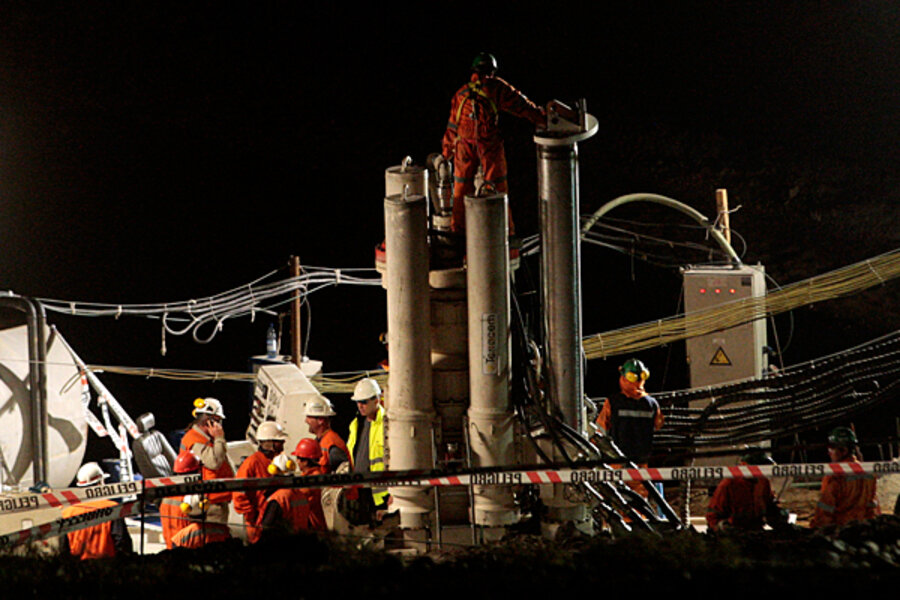Chilean miners cheer as drill starts digging them out
Loading...
| Santiago, Chile
The effort to rescue 33 trapped Chilean miners went into high gear on Tuesday as a 31-ton Raise Borer Strata 950 drill began to work round the clock drilling down to the men, a half-mile under the Atacama Desert.
The drilling will take about four months and even then, the resulting hole will only be large enough to haul up one miner a time. Officials estimate that once the hole is dug it will take three-to-four days to extract all the men. Chilean President Sebastián Piñera has dubbed the mission "Operation San Lorenzo," a reference to the patron saint of miners.
The drill, which was shipped to the site in pieces, bore a preliminary hole Monday evening. Drill operators now expect to carve out about 15 meters of rock per day. The process could take until after Christmas to drill a two-foot diameter hole down some 2,300 feet and install cages to lift the miners to the surface, according to Mining Minister Laurence Golborne.
After everything is installed, rescue workers will descend into the mine to help the men into the cages. Lifting each man to the surface will take roughly 2 hours.
"More important than time is that we avoid mistakes," Mr. Golborne told reporters today outside the mine in northern Chile.
3 rescues Chilean miners could take hope from
Yet time is very much a factor. Golborne said there are about 10 backup options currently on the table for the rescue, ordered by President Piñera to speed the process as much as possible.
If the Strata 950 should fail, then a backup Strata 950 drill is waiting in the wings. If the backup drill also fails, a T-130 drill could be used to widen an already existing hole that reached the miners shortly after they were found.
“The Strata has begun digging, an important first step,” Golborne said. “The installation phase was very complex, which was done in record time considering what it normally takes to install this machine.”
Self help
The trapped miners will also assist in their rescue from below, storing several thousand tons of debris as it tumbles down a mine shaft near the shelter. Taking part in their own liberation could prove beneficial as the miners’ mental and physical health becomes a concern, officials say.
NASA is sending two physicians, a psychologist, and an engineer this week to provide nutritional and psychological support to the miners.
The arrival of the drill's final piece on Monday evening was greeted with applause by the miners’ families who have been camped outside the mine since it caved on Aug. 5. No word was heard from the miners for 17 days until a drill breached their subterranean refuge on Aug. 22. When workers pulled the drill back out, it had a note attached: "We are fine in the refuge, the 33."
Families have crowded into tents at Camp Hope outside the mine, praying their loved ones would be rescued from the belly of the Atacama Desert.
This nation of 17 million people has rallied around the plight of the miners. Many here have been waving and hanging the Chilean flag, even though this is prohibited by law except for on approved holidays.
Since the contact hole was dug families have been exchanging letters – called palomas or doves – with their loved ones, and the miners have responded with a short video of their life in the refuge. They ask for their favorite foods and things to entertain themselves while they wait. They also asked for cigarettes, which were denied.
Separately, mining company San Esteban has come under heavy scrutiny for apparently failing to comply with safety regulations at the mine, even after the same mine was closed in 2007 over the death of a worker. The company is now facing numerous lawsuits.





